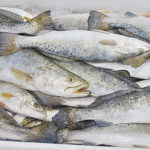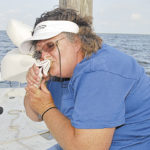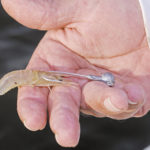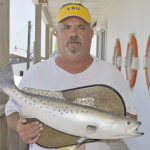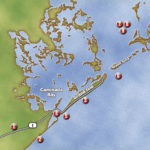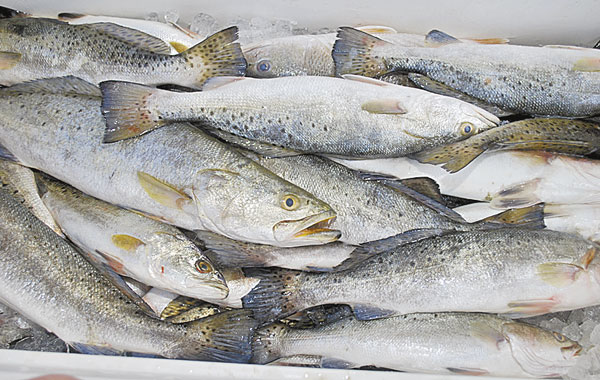
Can’t find fish this month around Grand Isle? Then you just aren’t trying.
Grand Isle!
The name of the place is enough to hold the fascination of anyone carrying an ounce of the sea’s romance. The following passage describes the island perfectly: “Truly, Grand Isle has grown up. Grown from a quiet, peaceful village beneath the sheltering oaks surrounded by broad treeless prairies and marshlands to a bustling seaside resort with modern conveniences and catering to modern tastes and demands.
“Unchanged, though, is the sea, the bays and the many bayous and lakes that surround it. Unchanged, too, are the hordes of game fish that swim in these waters and the urge of anglers to congregate here for their taking.”
The description of the island was written by the legendary outdoor writer Arthur Van Pelt, editor of the “All Outdoors” column for the New Orleans Times-Picayune newspaper, outdoor commentator for WNOE radio and president of the Louisiana Outdoor Writers Association. It was written in the summer of 1952.
Now, 58 years later, I am sitting on the porch of Mi Mi’s, the Cristina family camp in Chenier, a piece of the Town of Grand Isle that lies before the bridge to the island proper. The porch overlooks Caminada Pass, and the camp has been flung wide open to allow the soft Gulf breeze to caress our skin as it lazily wends through the old building. The setting sun hangs low over the back of my right shoulder.
Sitting in wooden rockers, Chuck and Zelita Cristina talk about how they feel about Grand Isle.
“I think that the access to different spots is one of the greatest assets here,” says Chuck. “You can pick and choose when and where to fish. There are so many options.”
Zelita, who goes by “Z,” chimes in.
“I really like it here,” she says. “It’s a slower, nicer way of life. I would live down here after we retire. Sometimes, Chuck leaves me down here one weekend and doesn’t come back to get me until the next. No car. I just fish and crab all day. There’s everything here you really need. Even the air is different down here.”
Chuck nods his head in affirmation.
“Not to have this place would devastate me,” he said. “When I was sitting in a bar in Houston watching Katrina bear down on TV, an oilfield worker sitting next to me said, ‘Why do you have a tear in your eye? What’s wrong?’”
I study the couple closely as they talk. Both are in their early 50s. Chuck has salt-and-pepper gray hair, wears a grizzled goatee and has intense mischievous brown eyes. His gravelly voice carries a noticeable New Orleans accent, even though he has lived in Jefferson Parish all his life.
Z’s long, frosted hair is pulled back in a ponytail. She has a cherub’s face and a sweet, melodic voice. She is the perfect foil for her crusty partner.
“We fish pretty regularly,” admits Chuck, “unless the [LSU] Tigers are playing. Then it’s a problem. I haven’t missed a home game in 33 years. I am a major fan. Z likes to fish as much as me. And that’s saying a lot.”
“We went fishing in Venice for our honeymoon,” confides Z.
“Who is the better fisherman?” I ask.
“That’s debatable,” answers Z with an evil but sweet grin. “We are competitive.”
“Yeah,” rumbles Chuck, “who catches the most fish doesn’t have to clean the catch.”
He thinks a moment, then adds, “I created a monster; I ain’t gonna lie.”
The next morning comes early. At daylight, the Cristinas launch their boat and buy a supply of live shrimp and cocaho minnows at Bridge Side Marina. They cruise down the north side of the island, out Bayou Fifi and northeast across the Barataria Waterway.
The option that they will explore first, explains Chuck, will be to fish near oil and gas platforms in Barataria Bay north of Queen Bess Island and east of Mendicant Island. Their last trip to the spot produced an ice chest of specks of mixed sizes.
Five boats are already at the big wooden platform, four anchored on the downcurrent side and one upcurrent of the rig. Chuck eases the boat into the last remaining downcurrent slot, and quietly drops the anchor.
Both anglers rig up to use live shrimp. Chuck impales his shrimp on the bare hook of a 3/8-ounce jighead. Z uses her favorite set-up, a Carolina rig weighted with a 1/2-ounce sliding egg sinker over a snap swivel.
Chuck strikes first with a small but legal speck; then another. Meanwhile, Z reels in a 10-incher, surreptitiously kisses it on the snout and releases it.
“For good luck,” she explains shyly when she catches me watching her.
The specks are small but yield willingly to the persistent anglers.
“We are not about chasing trophies. We just love to fish,” explains Chuck.
The explanation sounds odd coming from a man who just won the boat we are in, a 19-foot Nautic Star with a 90-horsepower Mercury outboard motor, by catching the largest speckled trout in the Southeast Division of the Coastal Conservation Association STAR Tournament.
I ask him about the 7.54-pound fish. He warms to the subject quickly.
“I caught it about 60 yards from the front porch of the camp,” he says. “Amazing! The eastern end of Elmer’s Island has built a long sand bar into Caminada Pass right in front of the camp, leaving a stretch of water maybe 70 yards wide between it and the camp.
“I was wading across it and saw a bunch of mullet scatter in water about 2 feet deep, so I threw my Carolina-rigged cocaho right into the middle of them. I must have hit her on the head, because she took it as soon as it hit the water.
“I didn’t have a landing net, so I had to holler for Z back at the camp to bring one. I just led the fish round and round in a circle until she got there with the net. I caught it the day after the STAR started, so I had to sweat getting beat the whole summer. But I did win the Grand Isle Speckled Trout Rodeo with it right away.
“I was in the STAR just for the tagged redfish. After I caught the fish, my neighbor told me, ‘Hey, you might have won the STAR.’ So we weighed it Bridge Side Marina.”
The pair continues to peck away at the fish. Occasionally, Chuck substitutes a cocaho for a shrimp, but the specks won’t have any of it. They want shrimp. Neither angler passively soaks their bait on the bottom. Rather, they slowly retrieve their baits, slightly bouncing them off the bottom during the retrieve.
Chuck explains that except when they fish under the lights of their camp wharf at night, they always fish with live bait.
“Z has had three shoulder surgeries; constant casting is hard on her,” he says.
But his compassion doesn’t extend to their competition when fishing. Chuck is ahead on the body count, and his banter, always referring to her as “Mama,” is constant, and usually accompanied by an evil laugh. Z takes the teasing well, but is clearly chagrinned by being outfished.
When the fishing slows, Chuck picks up the anchor and grunts, “Let me show you some of the other options for Grand Isle trout fishing.”
First stop is the bridge over Caminada Pass that links the island to the mainland. The tide is rising, the way the couple likes it when fishing at the bridge. They anchor the boat upcurrent and let it drift back to within casting distance of the bridge’s pilings.
Fishing is slow, so up comes the anchor again. They head out the pass. The rock jetty on the east side of the pass, a favored fishing spot, is not an option today. A work crew on a barge is driving pilings there, probably to install a navigational aid.
On the opposite side of the pass lies “Gorillaville,” a massive natural sand shoal that extends hundreds of yards into the Gulf. Receiving its informal name from the fearsome breaking waves that seem to be present in all but the calmest weather, it is considered a hotspot for speckled trout action.
Chuck swings the boat wide into the Gulf and around the end of the shoal, then back into shallow water into a spot calm enough to anchor. Here, as at the bridge, nothing is kicking.
Option four: fish the open beaches of Elmer’s Island.
This one pays off. After a short run, Z directs Chuck’s attention to a flock of diving gulls. The birds are wailing away at shrimp that have been driven to the surface by the attacks of fish from beneath them.
Chuck positions the boat with his trolling motor to intercept the action. Z gets her revenge. Both catch specks in the melee, but Z catches more. And these trout are bigger than those caught earlier in the morning.
The school of shrimp and fish move and submerge several times, only to reappear a short ways farther up the beach. Always the action is given away by the wheeling and diving birds.
Using live-bait rigs instead of plastic on jigheads clearly slows the two anglers down. Bird trout are notorious for biting anything thrown at them in the feeding frenzy, so Chuck decides to give himself an edge by dispensing with live bait and jamming a plastic tail on his jig head.
But in the excitement, the bail of his spinning reel flips shut during his first cast. The line parts with a loud snap, and Chuck’s lure disappears out of sight.
He is clearly aggravated. Z quietly smirks while she unhooks her latest victim.
After the trip, the cool shade beneath the elevated camp is welcome. Chuck sits pensively in his porch swing staring at the cooler full of speckled trout that need cleaning, while Z putters around the camp.
He looks tired.
“How long before you retire?” I ask.
“One year; one more year,” he replies.
“Whatcha gonna do then?”
“You are looking at it, man — fish and more fish.”
